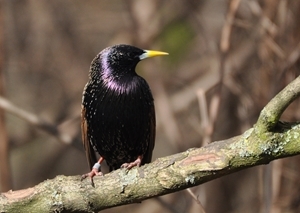 The Game and Wildlife Conservation Trust (GWCT), supported by Limestone Journeys in partnership with Lesley Sharpe, a local farmland environment adviser will be giving Derbyshire farmers an opportunity of learning how to identify the everyday birds that live on their farms by attending a farmland bird ID day on the 5th February at Elmton, near Bolsover in Derbyshire.
The Game and Wildlife Conservation Trust (GWCT), supported by Limestone Journeys in partnership with Lesley Sharpe, a local farmland environment adviser will be giving Derbyshire farmers an opportunity of learning how to identify the everyday birds that live on their farms by attending a farmland bird ID day on the 5th February at Elmton, near Bolsover in Derbyshire.
The aim of the training is to help farmers participate in the GWCT’s 2015 Big Farmland Bird Count which will take place between 7th and 15th February 2015. So far more than 1,600 farmers are registered to take part in this country-wide survey.
Lesley Sharpe is delighted that together with Limestone Journeys she is able to support the GWCT’s Big Farmland Bird Count by organising this special bird ID day.
Lesley Sharpe said “We are running this event because it is really important that as many farmers as possible in Derbyshire get behind the Big Farmland Bird Count and brush up on their birding skills. At the event I’m looking forward to hearing from expert RSPB birder Kirsty Brannan on the best ways of identifying our farmland birds, particularly those harder to recognise birds, that we call ‘Little Brown Jobs’. The day will give people the confidence to recognise their own birds and this will prove invaluable when they take part in the actual count at the beginning of February.”
This free Bird ID day will run from 11am to 3pm and an attractive Bird ID guide will be given to participants. Following lunch, which will be provided, there will be an interesting farm walk where newly learned skills will be put into practice. The farm walk is courtesy of AD & AA Jessop.
The GWCT believes that the efforts being made by farmers to reverse bird declines frequently go unrecognised despite them being vital in safeguarding the future of many of our most cherished bird species such as skylark, yellowhammer, corn buntings and wild grey partridges.
Jim Egan from the GWCT explains, “Our Big Farmland Bird Count helps to remedy this as it showcases some of the remarkable conservation efforts being carried out by farmers, landowners and gamekeepers such as providing supplementary over-winter food or by growing wild bird seed mixes. It is also a useful way to measure how birds are faring on our farms across the country. Once farmers are aware of what birds they have on their farm, they can more accurately target the recovery of individual species by putting in place specific conservation measures.”
For those interested in taking part in the Big Farmland Bird Count, the GWCT is providing a simple tick sheet that can be downloaded from the GWCT’s website and taken into the field to record any sightings. Participants will then be able to send the results either via a dedicated web page or through the post. The GWCT is inviting people to spend about half an hour recording the species and number of birds seen on one area of the farm. To download information or register to take part, please visit: www.gwct.org.uk/bfbc.
To book a place to attend the free Bird ID day, in Derbyshire, sponsored by Limestone Journeys, please contact Lesley Sharpe by telephoning: 07707 220121.
For more information on the GWCT’s Big Farmland Bird Count, please contact: Morag Walker by email: mwalker@gwct.org.uk or by phone: 07736 124097
The GWCT’s Big Farmland Bird Count has captured the imagination of all those interested in the future of farmland birds. Sponsored by BASF, the count is run in partnership with the FWAG Association and LEAF and receives grateful support from a wide range of farming and industry organisations such as RSPB, Kings, Waitrose, NFU, Soil Association, CFE, CLA, Heather Trust, Conservation Grade, and Countryside Alliance.
END
Photocaption: Starlings were seen on over 40% of the farms taking part in the GWCT’s 2014 Big Farmland Bird Count and were the most abundant bird recorded. Starling numbers have declined markedly across much of northern Europe and the UK. Picture credit: Peter Thompson, GWCT.
Notes to editors
The Game & Wildlife Conservation Trust – providing research-led conservation for a thriving countryside. The GWCT is an independent wildlife conservation charity which has carried out scientific research into Britain’s game and wildlife since the 1930s. We advise farmers and landowners on improving wildlife habitats. We employ 22 post-doctoral scientists and 50 other research staff with expertise in areas such as birds, insects, mammals, farming, fish and statistics. We undertake our own research as well as projects funded by contract and grant-aid from Government and private bodies. The Trust is also responsible for a number of Government Biodiversity Action Plan species and is lead partner for grey partridge and joint lead partner for brown hare and black grouse.
For information, contact:
Eleanor Williams
Telephone: 07592 025476
Email: press@gwct.org.uk